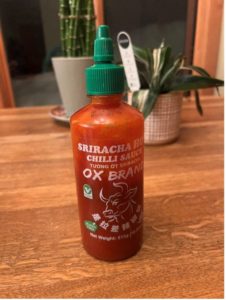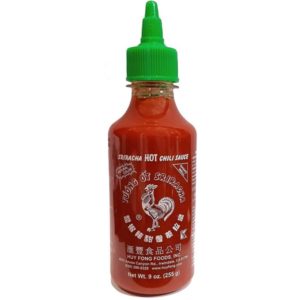
Employment Practices Liability Insurance
Share Post: I am lucky enough to work with some extremely fantastic local businesses in Colorado. Our team works on all sorts of employment issues
Sriracha, a fiery red sauce that has captured the taste buds of spicy food enthusiasts around the world, offers not just a kick of heat but also a fascinating study in the realm of trademark and trade dress law. Originating from the coastal city of Si Racha, Thailand, this sauce has transcended its humble beginnings to become a global culinary phenomenon. However, its journey into kitchens and restaurants worldwide brings to light intriguing legal challenges, particularly regarding its trademark and trade dress.
The story of Sriracha in the United States is often associated with Huy Fong Foods, a company founded by David Tran, a Vietnamese immigrant of Chinese descent. Tran’s version of Sriracha, known for its bright green cap and rooster logo, has become synonymous with the term “Sriracha” in the U.S. However, the sauce itself is named after the city of Si Racha in Thailand, where it was first created by Thanom Chakkapak. This dual origin story sets the stage for a complex discussion on trademark and trade dress within the food industry.
Trademark laws are designed to protect brand names, logos, and other identifiers that distinguish the source of goods or services. Trade dress, a subset of trademark law, covers the visual appearance of a product or its packaging, which signifies the source of the product to consumers. The distinctiveness of Huy Fong Foods’ Sriracha bottle design—its color, shape, and labeling—plays a significant role in its brand identity, making trade dress a crucial aspect of its legal protections.
One of the most intriguing aspects of Sriracha’s trademark and trade dress saga is the question of genericide and the challenges of protecting a name that originates from a geographic location. Unlike other brands that have fought against their brand names becoming generic terms (such as Aspirin and Escalator), Sriracha’s situation is unique because its name is derived from a place, much like Champagne or Parmesan. This presents a challenge in trademark law, as, absent a showing of secondary meaning, geographic names are not typically granted trademark protection since they describe where a product is from rather than a specific brand or manufacturer. Arguably, Huy Fong Sriracha had achieved that bar; however, we will never know.
Huy Fong Foods has never applied for an exclusive trademark on the name “Sriracha,” which has allowed other companies to produce and market Sriracha sauce under the same name, claiming there is no secondary meaning and that the mark is geographically descriptive. However, the company’s distinctive packaging and branding have become so closely associated with their product that the trade dress of Huy Fong’s Sriracha bottle is arguably more significant in preventing consumer confusion than the name itself. Huy Fong has a trade dress registration for “Hot chili sauces” which depicts a plastic bottle with green squirt top (Ser No. 74145492- note the lines on the top indicate the color green).

The legal landscape surrounding Sriracha highlights the importance of trade dress in the food and beverage industry. As companies strive to differentiate their products in a crowded market, the visual appearance of a product can be as critical as the product name in creating brand identity and loyalty. Huy Fong Foods’ success with Sriracha sauce illustrates how effective trade dress can enhance a brand’s market position, creating a visual trademark that is instantly recognizable to consumers.
However, a trademark registration is only as valuable as its owner’s willingness to enforce it. Just as Huy Fong’s failure to register rights for the name “Sriracha” lead to genericide/geographic descriptiveness issues, this trademark practitioner fears Huy Fong’s failure to enforce rights in its trade dress registration will lead to a similar outcome.
Last night as I sat down to dinner, I went to the pantry to grab some hot sauce. Knowing there has been a shortage of Sriracha sauce in the global markets, I was relieved to see a green top greeting me from our hot sauce corner of the pantry. I grabbed the sauce and applied it generously to my dinner. After one bite I felt something was a bit off regarding the flavor. As I inspected the bottle further, I realized it was this:

Not:

In that moment, I was a consumer experiencing confusion as to the origin of my goods- in this case delicious hot sauce. Consumer confusion is the gravamen of trademark infringement. I am hopeful that Huy Fong will turn up the heat and, after failing to protect its name, will enforce its registered trade dress rights so next time I reach for the green top, I am greeted by a familiar deliciousness and not let down by a mere knock off pirating the original’s goodwill.
The case of Sriracha sauce offers a spicy take on trademark and trade dress law, serving as a reminder of the complexities businesses face in protecting their brands in a global marketplace. It underscores the significance of visual branding and the challenges of maintaining trademark rights, especially when a product’s name is inherently generic or geographically descriptive. It further underscores the necessity for consumer facing goods to police their registrations and enforce their rights against potential infringers. As Sriracha continues to enjoy its status as a beloved condiment worldwide, it also stands as a testament to the intricate dance between culinary tradition, geography, branding, enforcement, and the law.
ABOUT THE AUTHOR
MANAGING PARTNER
The founder of Milgrom & Daskam, Jonathan (Jon) Milgrom advises businesses of all sizes and works across a variety of sectors. His diverse client-base includes companies in tech, software, fintech, health insurance, brewing and distilling, retail, graphic design, and other creative industries. He also advises a number of family-owned businesses.
More Articles

Share Post: I am lucky enough to work with some extremely fantastic local businesses in Colorado. Our team works on all sorts of employment issues

Colorado’s commitment to reducing greenhouse gas emissions and promoting energy efficiency has culminated in the enactment of Regulation 28, officially titled “Building Benchmarking and Performance Standards.” This regulation is a key component of the state’s broader efforts to address climate change, aiming to significantly reduce energy consumption in commercial buildings. For property owners, this regulation represents both a challenge and an opportunity—one that requires careful navigation to ensure compliance and avoid potential penalties.

An Indiana zoning case recently dredged up the age-old law school conundrum of what constitutes a sandwich and why we should care. Well, maybe the court didn’t actually weigh in on why we should care… but, it did make a determination that the taco IS, in fact, a sandwich.
If you’d like more information about who we are and what we do, please reach out to set up a free consultation.
© 2024 Milgrom Law, PC | DBA Milgrom & Daskam.